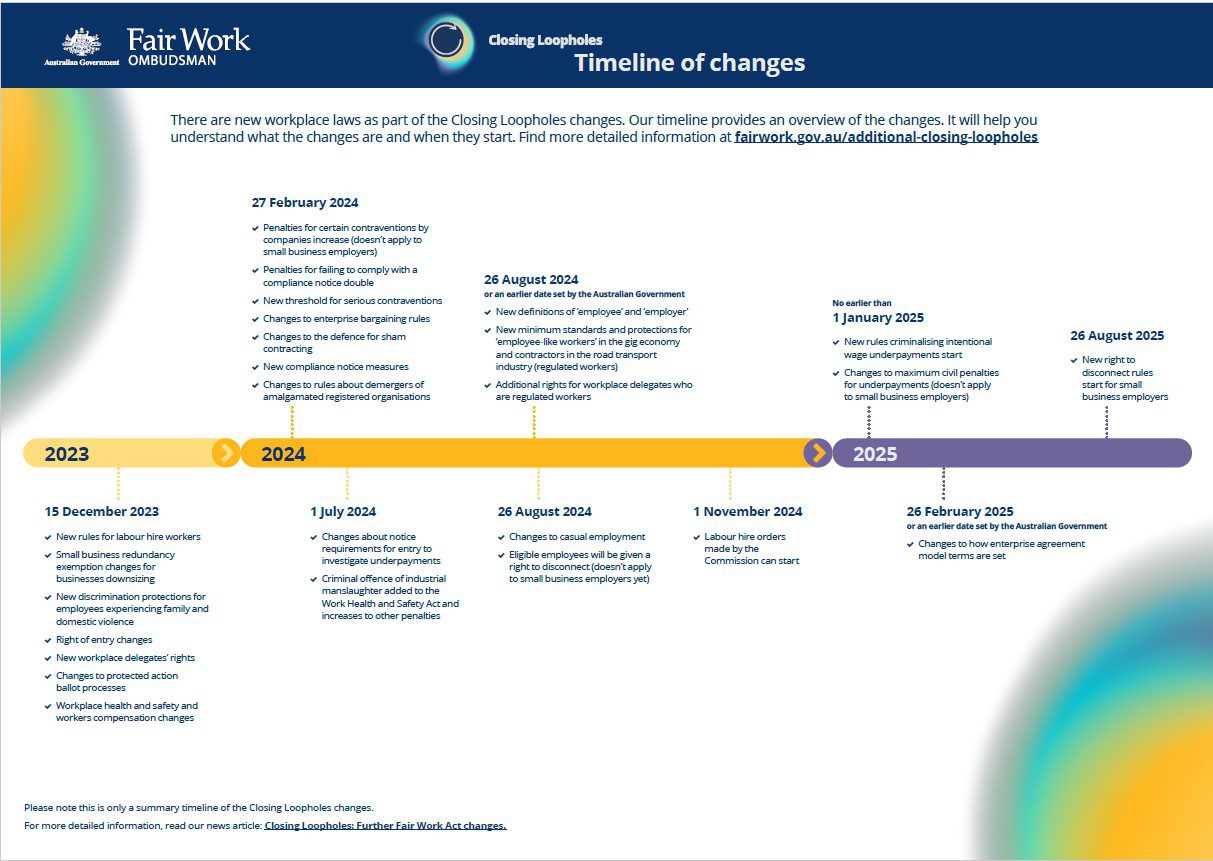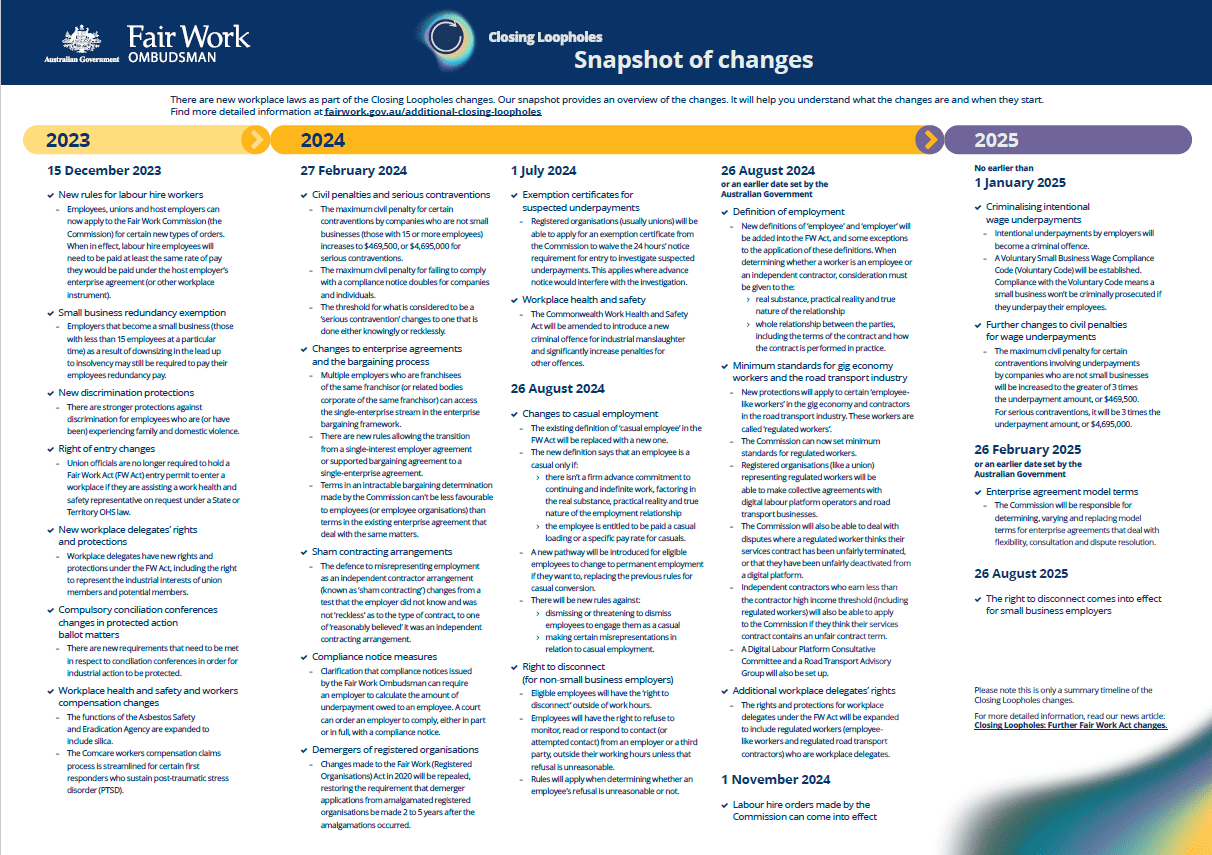INTRODUCTION
Welcome to our latest Newsletter and Case Update for 2024, where we aim to keep you up to date with all that is happening in the law affecting workplaces, and with what we have been doing here at KJK Legal.
In this edition, you can expect to read about:
- Doyles’ Guide rankings;
- Suzana’s observations on hybrid working arrangements post maternity leave;
- International Women’s Day Luncheon;
- SISA’s Closing the Loop conference for 2024;
- Updates on topical Employment and Industrial issues;
- Recent decisions from the South Australian Employment Tribunal (SAET); and
- Recent legislative amendments affecting the SAET Act.
Firm News
Doyle’s Guide rankings

We are proud to announce that KJK Legal has been recognised as a First Tier Workers Compensation Defendant Law Firm in the prominent legal industry Doyle’s Guide 2023 rankings.
Congratulations also to our Directors, Tracey Kerrigan, Neville John, and Mark Keam for being individually recognised, with Tracey being noted as ‘preeminent’ in the field. Recognition was also shared with our Special Counsel, Chrissy Psevdos, who joined our team in mid-2023. We are also delighted to share that, in 2024, our firm has been recognised as a Recommended Leading Workplace Health & Safety Law Firm by Doyle’s as well.
They said ‘yes’ to hybrid work post maternity leave – some personal observations by Suzana Jovanovic

Becoming a parent for the first time is both rewarding and challenging. I am realising that more and more as time goes on. In addition to nursing my newborn, constant nappy changes, cleaning, cooking, washing, ironing etcetera, I also yearned for intellectual stimulation.
Once my baby had his 6-week immunisations, I told the directors that I was ready to return to work. They welcomed me with slightly puzzled faces. However, after explaining that this would require me to work from home on a part-time basis and attending the office once a week for the purpose of exchanging files and catching up on administrative work, I was welcomed with nothing but support.
Our staff have been equipped to work from home as a result of the COVID-19 pandemic. Whilst, I had previously worked from home on several occasions, this hybrid work model has been a life saver and game changer following my return from maternity leave.
Productivity is personal but having an employer who trusts that their staff will do the right thing is beneficial for both the employer and employee. I am still required to record my billable hours and meet deadlines which keeps me feeling accountable. However, I just do things differently. For instance, rather than meeting with clients or witnesses in person, I do so via Zoom or MS Teams. I attend Directions Hearings and Conferences by phone and I attend to my baby’s needs and house chores in between.
These flexible working arrangements have allowed me to contribute to my baby’s daily development and not miss out on his milestones. Due to the unpredictable schedule set by my child, I have in turn also gained new and further developed certain skills. Of course, I am not invincible, and it is no secret that life changes dramatically after having a baby. However, the days that I spend on the phone to my colleagues or in the office, have helped foster connections and having them regularly check up on my wellbeing just goes to show why KJK Legal is a recommended Leading Workplace Health & Safety Law Firm.
Less commuting, an ability to earn money, keeping intellectually stimulated, not missing out on my baby’s milestones, feeling a sense of self fulfillment, and having my employer’s trust are some of the benefits of working remotely and having a smooth return to work following maternity leave. Perhaps, I have the pandemic to thank for this, but then again, I think the workplace is what makes hybrid work.
Employees can request flexible working arrangements. However, depending on your business structure there may be reasonable grounds to refuse a flexible working request. If you would like some advice from an employer’s perspective on requests for flexible working arrangements and Work, Health & Safety issues, then please contact us.
International Women’s Day Luncheon #Inspireinclusion #IWD2024

On 8 March 2024 the ladies of KJK Legal attended the South Australian Business Chamber’s International Women’s Day Luncheon. Once again, we were graciously joined by some inspiring ladies and allied men from Lawson Risk Services.
The theme for this year’s International Women’s Day was to inspire inclusion; when women are empowered and included this creates a better world for all. This theme certainly resonates with us at KJK Legal as the firm is made up of 80% women.
We heard from three incredible women, who each won the 2023 South Australian of the Year in different categories. Tiahni Adamson, a leading Wildlife Conservation Biologist, Rachel Zaltron OAM, the founder of the fantastic charitable organisation Backpacks 4 SA Kids, and Sister Meredith Evans, a Sister of Mercy with a passion for social justice and the rights of refugees.
These inspiring women discussed their careers, the challenges they have faced being women in their respective positions and workplaces, and their hopes for the future.
KJK Legal would like to thank the team at Lawson Risk Services for joining us to celebrate such an important day in the firm’s calendar. We look forward to celebrating International Women’s Day again next year.
SISA – Closing the Loop – Prepare. Perfect. Protect.
KJK Legal are proud to announce their ongoing sponsorship of the Self Insurers of South Australia (SISA) Closing the Loop Conference on 19 September 2024.
Once again, this successful series will be held at the Morphettville Racecourse and the 2024 Conference plans to focus on up-to-date safety, wellness and return to work issues. The theme for this year is ‘Prepare, Perfect, Protect’, and will aim to have sessions that allows participants to:
- Prepare to execute their work and/or personal life role;
- Perfect processes and ensure the best possible safety and return to work outcomes for employees; and
- Protect employees with improved mental health practices, technological advancements, and procedural governance.
Not only is our team excited to be a part of what is sure to be another beneficial day for participants, we are looking forward to catching up with as many of you as we can. Do not forget to put the date in your diaries and register to attend this great event.
Update on Employment & Industrial Issues
Leave a message at the tone: The Right to Disconnect
At our mid-year client seminar last year, we discussed with the participants the possibility of a Right to Disconnect Bill passing through Federal Parliament, and the implications on employers.
On 12 February 2024, the Bill was passed and the Right to Disconnect was implemented into the Fair Work Act (Cth).
In case you weren’t there for our seminar, the Right to Disconnect grants employees a workplace right to refuse to monitor, read or respond to contact from their employer outside of their ordinary hours of work.
Although the meaning of ‘contact’ has not yet been defined, it will likely be broadly interpreted to include calls, emails, text messages and messaging on platforms such a Skype, Zoom or Teams. ‘Contact’ interestingly also includes third parties such as clients or customers.
However, there is a catch. Refusal must be ‘reasonable’. Although the legislation does not have an exhaustive definition of ‘reasonable’, there are a number of factors that must be considered:
- Why the contact is being made.
- Whether the employee is being compensated for reading and responding outside of their normal hours.
- The level, role, and responsibilities of the employee, and
- The mode of contact and whether it is disruptive.
While we would certainly encourage employers to try to resolve disputes at a workplace level first, the Fair Work Commission now has the right to consider disputes between employees and employers on this issue. The Fair Work Commission will have the ability to make an order that employers stop contacting employees and stop employees from refusing contact if it is reasonable.
It will be interesting to see how the Right to Disconnect will interact with existing employment standards such as reasonable additional hours, overtime entitlements and work, health and safety obligations. We also suspect this right will lead to many General Protections Claims.
We highly recommend employers review their internal policies with respect to out of hours contact, use of work technology and feedback mechanisms, and then implement procedures such as boundary education for staff, and scheduling emails and tasks during agreed working hours.
Should you have any questions or need assistance reviewing your internal policies and procedures, please do not hesitate to contact our Industrial Relations Team, Neville John or Matilda (Tilly) Wise, on 08 7324 7800.
Changes to Paid Parental Leave from 1 July 2024
There are more changes to Parental Leave Pay from 1 July 2024. If your child’s birth or entry into care is on or after 1 July 2024, these changes will affect you. The total Parental Leave Pay available to families is increasing to 26 weeks by 2026. How many Parental Leave Pay days your family will get depends on your child’s date of birth or adoption.
| Child’s date of birth or adoption is from | Your family can get up to |
| 1 July 2023 | 100 days |
| 1 July 2024 | 110 days |
| 1 July 2025 | 120 days |
| 1 July 2026 | 130 days |
If you have a partner, some days will be reserved for each of you to use. How many days you have reserved depends on your child’s date of birth or adoption.
| Child’s date of birth or adoption is from | How many reserved days you each have |
| 1 July 2023 | 10 days |
| 1 July 2024 | 10 days |
| 1 July 2025 | 15 days |
| 1 July 2026 | 20 days |
You’ll need to decide how to use the rest of the days as a family.
To get all days, both parents need to claim and be eligible. If only one parent in the couple is eligible, the reserved days still apply. There are some exemptions to these limits.
If you’re a single parent, you can get all Parental Leave Pay days. However, if you choose, you can give approval to share days with another parent.
If you have a partner, you can take some Parental Leave Pay days at the same time as them. If your child’s birth or adoption is before 1 July 2025 you can take up to 10 days at the same time. If their birth or adoption is from 1 July 2025 you can take up to 20 days at the same time. There are some exemptions to these limits.
Changes to the Fair Work Legislation Amendment (Closing the Loopholes) Act 2003
As many would know, the Fair Work Legislation Amendment (Closing the Loopholes) Act 2003 has received Royal Assent. Some changes have already come into force while others are yet to. The below image is a timeline of key dates to look out for which has been published by the Fair Work Commission. One of the key dates pertains to the Right to Disconnect (covered by Matilda Wise above), which takes effect on 26 August 2024.
To access a more detailed timeline of the changes, please refer to the Fair Work Commission’s website.


New offence of Industrial Manslaughter introduced under the Work Health and Safety Act
As discussed at our Industrial Relations Seminar last year, the Work Health and Safety (Industrial Manslaughter) Amendment Bill has passed through South Australian Parliament. This Bill aimed to introduce a new offence into the Work Health and Safety Act (2012) (“the Act”), namely Industrial Manslaughter.
This new law will commence on 1 July 2024.
As a reminder, here is the important information you need to know about Industrial Manslaughter before the law commences:
- The offence will apply to a person conducting a business or undertaking (“PCBU”), or an officer of a PCBU, who holds a duty under the Act. Workers cannot be charged.
- The new laws will not impose new duties on a PCBU that do not already exist however they are designed to reflect the severity when a death is caused as a result of such a breach.
- To be found guilty of Industrial Manslaughter a PCBU must:
- Have a health and safety duty.
- Have engaged in conduct that breaches that duty.
- Engage in conduct that causes the death of an individual to whom that duty is owed.
- Engage in the conduct with gross negligence or act recklessly as to the risk to an individual or death or serious injury or illness.
- The maximum penalty will be $18 million for a body corporate and a maximum of 20 years imprisonment for an individual.
- This offence will be subject to a 2-year statute of limitations for legal action like all other breaches of the Act.
- There will be 3 alternative outcomes if the finder of fact is not satisfied that the PCBU is guilty of Industrial Manslaughter, but they have failed to comply with their health and safety duty. The criteria that must be satisfied for each alternative category are:
- Category 1 – Failure to comply with health and safety duty, without reasonable excuse engages in conduct that exposed an individual to whom that duty is owed to risk of death or serious injury or illness and acting recklessly as to risk an individual to death or serious injury or illness.
- Category 2 – The PCBU has a health and safety duty, they fail to comply with this health and safety duty and expose an individual to risk of death or serious injury.
- Category 3 – The PCBU has a health and safety duty and they fail to comply with this health and safety duty.
Recent decisions from the South Australian Employment Tribunal
Sullivan v Return to Work Corporation [2023] SAET 109
Topic: Commissioning letters to nominated assessors for permanent impairment assessment examinations
Commentator: Chrissy Psevdos
Background
The worker suffered work injuries affecting multiple parts of his body and those impairments had reached maximum medical improvement. The worker sought to have his impairments assessed by Dr Roberto D’Onise.
As happens often, some of the injuries claimed by the worker were accepted as compensable work injuries, and some were not. In relation to some of the impairments the worker wished to be assessed, the parties did not agree the relevant date of injury. The worker contended the date of injury may be relevant to a determination of whether impairments should be combined as either arising from the same trauma or the same cause for the purpose of then determining his entitlement to lump sum compensation.
This appeared to be, at least partly, a reason why there was conjecture between the worker and the requestor as to the information that should be provided to Dr D’Onise in the report request.
These issues caused a delay in the requestor arranging the medical appointment and forwarding the report request, which in turn resulted in an Application for Expedited Decision (AED) being filed by the worker.
A Commissioner of the South Australian Employment Tribunal (SAET) made orders on hearing the AED which directed the requestor to provide a report request to Dr D’Onise and to arrange an examination with him within certain time periods.
Pursuant to section 66 of the South Australian Employment Tribunal Act (SAET Act), the Compensating Authority filed an Application for an internal review of the orders made by the Commissioner.
Issue
Section 22 of the Return to Work Act 2014 (RTW Act) and the Impairment Assessment Guidelines (IAGs) provide, when a worker requests that they be assessed for the purposes of determining their level of permanent impairment, a proposed report request be provided to the worker, so the requestor ‘can consider’ any submissions made by the worker as to the content of the request. It is general practice that the request outlines the relevant history of the claim and the relevant medical evidence in order to assist the nominated assessor.
This matter considered what is required for the requestor, in preparation of the report request to the nominated assessor, and gave consideration of the ambit of section 115(1)(aa) of the RTW Act.
Held
The Trial Judge determined that section 115(1)(aa) of the RTW Act is limited to directions that are required to expedite an assessment, but otherwise determined that it is for the requestor to finalise the report as part of its statutory obligations. The role of the SAET is not to hear competing submissions and to determine the date of the injury to be communicated to the assessor. Where the discharge of that function results in a reviewable decision, then it is open to the SAET to deal with that issue when alleged factual inaccuracies that may be provided to an assessor lead to inaccuracies in the permanent impairment assessment report, by way of a hearing de novo (new hearing).
He also noted that while the IAG’s require the requestor to liaise with the worker to ensure all relevant and accurate information is provided to the assessor, it is the requestor who is to communicate directly with the assessor and the responsibility ultimately rests with the requestor to ensure that all relevant information is provided accurately to the assessor.
The Trial Judge further observed the requestor must ensure the worker is provided with the report request, be given at least 10 days to consider the request, and have an opportunity to raise any issues, errors or omissions before the report request is sent to the assessor.
Key Takeaway
The SAET does not have the power to intervene when the contents of a report request, for the purposes of a whole person impairment assessment, cannot be agreed.
A link to the full text of the case can be found here.
Anderson v Department for Education [2023] SAET 117
Topic: Discharging the burden of proof that a claimant’s hearing loss has not arisen from employment
Commentator: Chrissy Psevdos
Background
At 71 years of age, the worker continues to be employed by the Department for Education as a rural driver of a school bus. He works from Monday to Friday, driving 234 kilometres daily, 3 hours per day.
The worker drove on bitumen roads, where he would drive at about 100 kilometres per hour, but between 2015 and December 2020 he took a different route which included about 50 kilometres of dirt road. On the dirt roads, he was not able to go faster than 80 kilometres per hour because of corrugations and each trip took him longer to undertake. Driving the bus on the dirt road was very noisy, and at this time he was driving an older model bus.
The corrugations on the road meant the bus jarred and was constantly vibrating. The windows would rattle and sometimes the door as well. The passengers could also be very noisy, speaking loudly, screaming and carrying on, especially if there was a full bus.
The number of children on the bus varied from day to day, from five to twenty. He said he generally had the windows up when driving, as the air conditioning was on most of the time. He also had a radio on all the time when driving. He said he could hear the bus engine when driving and it was a constant source of noise. Each of the school buses had an engine at the front rather than the rear.
Issue
Whether the worker was regularly exposed to noise levels over 85dB(A) in the course of his employment driving the school bus.
This involved the Trial Judge considering whether the noise levels averaged 85dB(A) or more and, in turn, this formed the question as to whether the compensating authority had discharged its burden of proving the worker’s hearing loss has not arisen from employment with the Department.
Held
The Trial Judge found Dr Fagan’s evidence in the matter and his reliance of studies to be unreliable.
She acknowledged that whilst there could not be precise evidence as to exactly the noise levels on the bus actually driven by the worker in the period between September 2016 to December 2020, the Trial Judge found that Mr Dewing in undertaking noise level surveys, had made determined efforts to reproduce the conditions as much as possible. She considered his conclusions to be sound and the levels sufficiently below the 85dB(A) level to allow a margin of error.
The Trial Judge accepted Mr Dewing’s estimates as to the average noise exposure and Dr Hains’ opinion, based on those noise surveys, and concluded the worker was unlikely to have been exposed to noise driving school buses sufficient to damage his hearing.
On that basis the Trial Judge found, on the balance of probabilities, the compensating authority has proved its case that the worker’s noise induced hearing loss did not arise from employment with the respondent, and they had successfully rebutted the evidentiary presumption in s 9(2)(a) of the RTW Act.
Key Takeaway
Where noise level surveys can be undertaken so as to reproduce, to best efforts, the conditions described, and there is a solid medical expert opinion in support of the evidence, it is possible to rebut the statutory presumption – but it is not easy!
A link to the full text of the case can be found here.
Shepherd v The State of South Australia (in right of the Department for Child Protection) [2024] SAET 2
Topic: Injury following COVID vaccine
Commentator: Suzana Jovanovic
Background
The worker was employed as a Child and Youth Support Worker at Baptist Care SA (which had a subcontract with the Department for Child Protection). Amongst other things, the worker may have been required to provide care and support to a child or youth with a disability. In order to carry out his employment in the healthcare setting, the worker was required to receive three doses of the COVID-19 vaccine if he wished to continue performing such work.
The day after receiving his 3rd dose the worker experienced chest pain, which became worse over the next few weeks. He was diagnosed with having post-vaccine pericarditis and made a claim for compensation, which was rejected.
Issue
The most relevant issue was whether the worker’s injury (i.e. post-vaccine pericarditis) arose from employment and whether employment was a significant contributing cause of the injury.
It was argued by the employer that the direction regarding the vaccine mandate was not one made by the employer, but one that came from the Government generally and the employer had no option but to comply.
Held
The Trial judge held the injury arose as a result of not only the vaccine mandate but also the worker’s employment, which required him to have a booster shot in order to continue performing his duties. The dual contributing causes therefore resulted in the worker’s claim for post-vaccine pericarditis being found as compensable.
Key Takeaway
This decision does not prevent the Government from issuing emergency mandates, but if a mandate is issued and an employer requires its staff to undertake, e.g. vaccinations due to the mandate, that direction is clearly an employment direction. If an injury occurs as a result (and this of course will be a medical issue) then it is likely that the injury will be compensable.
Interestingly, in a recent decision of the Queensland Supreme Court, it was found that mandates pertaining to paramedics and police are unlawful in light of the Human Rights Act. Whilst the Queensland’s decision is not binding, it does not necessarily prevent the SA’s Tribunals/Courts from sharing these views in the future. The SA Courts have, by and large, found the Government mandates to be lawful.
As these types of cases can be complex, we encourage employers to seek legal advice regarding any post-vaccine claims made by their employees.
A link to the full text of the case can be found here.
Parmar v Return to Work Corporation of South Australia [2024] SAET 4
Topic: IMA assessments – is it conclusive evidence or not?
Commentator: Tracey Kerrigan
Background
The worker brought a claim for injury to her neck and lower back, which was accepted. As the claim progressed, consequential injury claims were made, including a claim for upper and lower gastrointestinal (GI) condition, including anal fissuring and bleeding.
Issue
The issue in dispute was ultimately her whole person impairment (WPI) for such conditions.
As part of the dispute resolution process, a section 22 assessment was undertaken by Dr Sethi who assessed nil WPI for upper and lower GI conditions and anus. The worker’s solicitor sought an assessment from Dr Jakobovits (gastroenterologist), who assessed nil WPI for upper GI and anus, and 3% for lower GI. Each party had issues with the other party’s report and whether it was compliant with the IAGs. They agreed to a referral from the SAET to an Independent Medical Adviser (IMA) and Dr Champion was the agreed IMA. By the time Dr Champion saw the worker it was 12 months past the original assessment. He assessed a significant impairment of 26% WPI (18% for the lower GI and 10% for the anal injury).
The respondent then sought to have Dr Champion called at trial (all of the above procedures occurred pre-trial) for cross-examination. The Trial Judge had to determine the Application and decided the party who seeks to call the IMA must demonstrate there are errors in the report. The RTW Act provides that the IMA opinion is conclusive evidence of the opinions expressed unless the SAET, in its adjudicative function, exercises its discretion and finds otherwise. There is a heavy onus on the party seeking to cross-examine the IMA that the IMA’s report is not compliant. After a forensic examination of the report and findings, the Trial Judge was not persuaded Dr Champion’s report was in error and declined the Application.
Key Takeaway
Be careful what you wish for. Referring an injured worker to an IMA, particularly prior to trial, can be an exercise in wishful thinking. The IMA is required to exercise their own judgement and opinion. Their opinion may be completely different to the PIA assessment on file. If the facts of the case have not been properly established, you may be ‘stuck’ with findings that are not borne out at trial.
The onus rests on the party asserting that the IMA opinion is not to be relied upon as “conclusive evidence”, and that is a heavy onus to meet.
A link to the full text of the case can be found here.
Statutes Amendment (South Australian Employment Tribunal) Bill 2024
Commentator: Suzana Jovanovic
The South Australian Employment Tribunal Act 2014 (SAET Act) came into effect a decade ago. However, as John F, Kennedy once said, “Change is the law of life. And those who look only to the past or present are certain to miss the future”. A new Bill has now been introduced which looks at amending the SAET Act. So, what can we expect by way of changes to the legislation? Here is a brief summary:
- Section 6 – would aim to clarify the assignment of matters between THE SAET sitting as a court vs as an industrial relations commission.
- Section 19 – when the SAET is acting as an industrial relations commission, this section would aim to provide additional flexibility to the president in the composition of the Full Bench by permitting Commissioners to sit as members of the Full Bench. However, at least one member of the Full Bench must always be a presidential member.
- Section 43 – currently, the maximum time frame for compulsory Conciliation Conferences in workers compensation matters is 6 weeks. The proposed amendment looks at increasing this time frame from 6 weeks to 10. An extension of time beyond 10 weeks is therefore likely to be regarded as an exception rather than the norm, which is often the case at this stage.
- Section 51 – the amendments here look at providing confidentiality of communications between non-legally qualified representatives and members in proceedings before the Tribunal. As most of our clients would know, there are a number of workers who are represented by union representatives, that do not necessarily hold legal qualifications. At this stage, communications between those union representative and workers for instance may be disclosed to an opposing party on demand. The proposed amendment is mainly aimed to protect the communications between union representatives and their members which would in effect trump the recent decision in Devies v Woolworths Group Limited.
- Section 65 – the section would allow the SAET to expand the scope of issues in dispute where the Tribunal is satisfied it is in the interests of justice to do so. In other words, if the parties cannot agree on whether a question should be determined by the Tribunal, then the SAET would have the ability to intervene and determine whether to expand the scope without necessarily having consent of all the parties to the proceedings. In turn, this section would aim to prevent unnecessary duplication by having separate Applications for Review filed, which we see all too often on this side of the fence.
- Section 92 – would permit the SAET to suspend inactive proceedings by placing the proceedings in a suspended matters list, pending the resumption of active litigation. We could be seeing this section come into force in matter where parties are awaiting the receipt of medical reports for instance.
If you wish to undertake further reading in relation to any of the decisions discussed above, they can be found on the Austlii website.

On a final note, we again take this opportunity to thank you for your ongoing patronage and wish you a happy and safe Easter break.
As always, should you have any queries, feedback or comments on anything we have discussed above, or advice on any workplace legal needs, then please do not hesitate to reach out to one of us.

